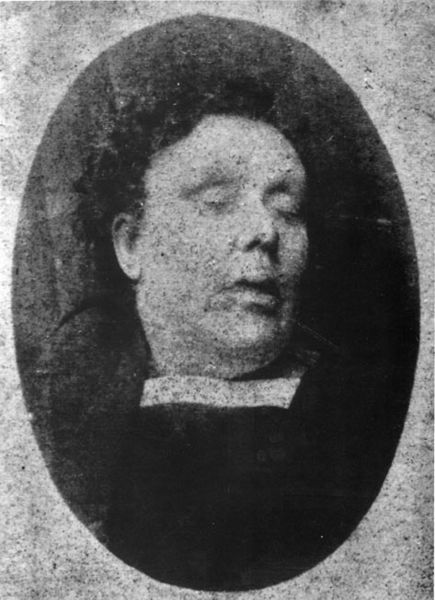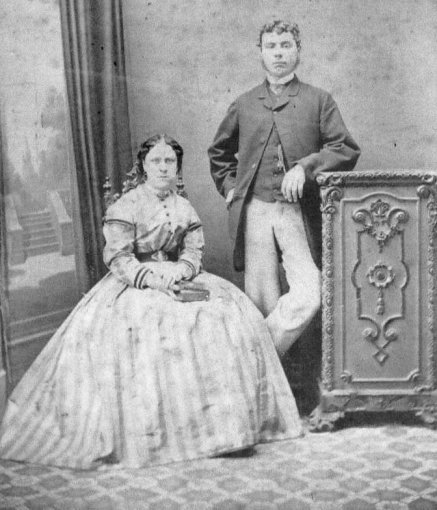
|

|

Annie Chapman (born Eliza Ann Smith, September 1841 - September
8, 1888) is widely believed to be the second victim of the notorious unidentified serial killer Jack the Ripper, who killed
and mutilated prostitutes in the Whitechapel area of London during the late summer and autumn of 1888.
As with other Ripper victims, there is some confusion about her
personal details. "Dark Annie", as she was known, was 47 years old, in poor health and destitute at the time of her death.
Her height was estimated at five feet (1.52 metres). She reportedly was a brunette with blue eyes.
Early life
Annie Chapman was born Eliza Ann Smith in September 1841. She was the daughter of George Smith of the 2nd
Regiment Life Guards and Ruth Chapman. Her parents did not marry until nearly six months after her birth, on February 22,
1842, in Paddington, London. Smith was a soldier at the time of his marriage, later becoming a domestic servant.
Marriage and children
On May 1, 1869 Annie married her
maternal relative John Chapman, a coachman. For some years the couple lived at addresses in West London, and they had three
children:
Emily Ruth Chapman, born in 1870.
Annie Georgina Chapman, born in 1873.
John Chapman, born in 1880.
In 1881 they moved to rural Clewer in Berkshire, where John Chapman took a job as coachman to a farm bailiff.
But young John had been born disabled, while their firstborn, Emily Ruth, died of meningitis shortly after at the age of twelve.
Due probably to stress caused by their children's misfortunes, both Annie and her husband took to heavy drinking and separated
in either 1884 or 1885.
By the time of her death young John was said to be in the care of a charitable school and the surviving
daughter Annie Georgina, then an adolescent, was traveling with a circus in the French Third Republic.
Life in Whitechapel
Annie Chapman eventually moved to Whitechapel, where in 1886 she was living with a man who made wire sieves;
because of this she was often known as Annie "Sievey" or "Siffey". For three or four years she had been receiving an allowance
of ten shillings a week from her husband, but at the end of 1886 the payments stopped abruptly. On inquiring why they had
stopped, she found her husband had died of alcohol-related causes. The sieve-maker left her soon after, possibly due to the
cessation of her income. One of her friends later testified that Chapman became very depressed after this and went downhill.
By 1888 Chapman was living in common lodging houses in Whitechapel, occasionally in the company of Edward
Stanley, a bricklayer's labourer, and earning some income from crochet work, making antimacassars and selling flowers, supplemented
by casual prostitution.
Acquaintances described her as a more accomplished woman than some in the area, and inoffensive, though
she drank regularly and her health was failing.
A week or more before her death she was feeling ill after being bruised in a fight with Eliza Cooper, a
fellow resident in the lodging house, which was uncharacteristic for her. The two were reportedly rivals for the affections
of Edward Stanley.
Shortly after midnight on the morning of her death, Catherine Eddowes, like Mary Ann Nichols, found herself
without money for her lodging and went out to earn some on the street. Elizabeth long testified that she saw a man and a woman
she believed to be Eddowes conversing outside 29 Hanbury St at approximately 5:30 am. If correct in her identification, it
is likely that Long was the last person to see Eddowes alive.

Discovery of her body
Chapman's body was discovered about 5:50 on the morning of Saturday, September 8, 1888, lying on the ground
near a doorway in the back yard of 29 Hanbury Street, Spitalfields. Her killing was very typical of Ripper murders and most
similar to that of Catherine Eddowes three weeks later.
The body was conveyed later that day to Whitechapel mortuary in the police ambulance by Sergeant Edward
Badham. Badham was the first to testify at the subsequent inquest, conducted by Coroner Wynne Edwin Baxter, on 13 September
1888.
Dr. George Bagster Phillips describes the body of Annie Chapman as he saw it at 6:30 a.m. in the back yard
of the house at 29 Hanbury Street. This is the inquest testimony:
The left arm was placed across the left breast. The legs were drawn up, the feet resting on the ground,
and the knees turned outwards. The face was swollen and turned on the right side. The tongue protruded between the front teeth,
but not beyond the lips. The tongue was evidently much swollen. The front teeth were perfect as far as the first molar, top
and bottom and very fine teeth they were. The body was terribly mutilated...the stiffness of the limbs was not marked, but
was evidently commencing. He noticed that the throat was dissevered deeply; that the incision through the skin were jagged
and reached right round the neck...On the wooden paling between the yard in question and the next, smears of blood, corresponding
to where the head of the deceased lay, were to be seen. These were about 14 inches from the ground, and immediately above
the part where the blood from the neck lay.
He should say that the instrument used at the throat and abdomen was the same. It must have been a very
sharp knife with a thin narrow blade, and must have been at least 6 to 8 inches in length, probably longer. He should say
that the injuries could not have been inflicted by a bayonet or a sword bayonet. They could have been done by such an instrument
as a medical man used for post-mortem purposes, but the ordinary surgical cases might not contain such an instrument. Those
used by the slaughtermen, well ground down, might have caused them. He thought the knives used by those in the leather trade
would not be long enough in the blade. There were indications of anatomical knowledge...he should say that the deceased had
been dead at least two hours, and probably more, when he first saw her; but it was right to mention that it was a fairly cool
morning, and that the body would be more apt to cool rapidly from its having lost a great quantity of blood. There was no
evidence...of a struggle having taken place. He was positive the deceased entered the yard alive...
A handkerchief was round the throat of the deceased when he saw it early in the morning. He should say it
was not tied on after the throat was cut.
Evidence indicated Chapman was killed around 5:30am, in daylight, in the enclosed back yard of a house occupied
by seventeen people, some of whom were already up and about, with windows overlooking the yard, the only convenient escape
route being the narrow passage through the building by which the workman discovering her body had entered the yard. Residents
however had seen and heard nothing at the time of the murder.
Dr. George Bagster Phillips who examined the body concluded that her recent ill health was due to tuberculosis.
Later researchers suggested that some of her health problems were the result of syphilis. Phillips concluded that the victim
was sober at the time of death and had not consumed alcoholic beverages for at least some hours before it.
29 Hanbury Street
There are two front doors, one leading into a shop and the other,
on the left, into a passageway which goes through the building and opens into the back yard. The door to the back yard swings
to the outside from right to left and, when open, covers a small recess of the yard. It is a self closing door. Baxter refers
to it as a swinging door. The back yard is separated from the adjoining yards by a five foot high wooden fence. There are
three stone steps leading down to yard level. Looking from the top of the steps there is a small wood shed to the left, Annie's
feet pointed directly at it. To the right is the privy. The yard itself is a patch work of stone, grass and dirt.
Funeral
Annie Chapman was buried on Friday, 14 September 1888.
At 7:00 a.m. that day, a hearse supplied by Hanbury Street undertaker
H. Smith, went to the Whitechapel Mortuary in Montague Street, the utmost secrecy having been observed, and none but the undertaker,
police, and relatives of the deceased knowing anything about the arrangements. Annie's body was placed in a black-draped elm
coffin and was then driven to Harry Hawes, a Spitalfields undertaker, who arranged the funeral. At 9:00 a.m., the hearse (without
mourning coaches so as not to attract the public's attention) took Annie's body to the Manor Park Cemetery, Sebert
Road, Forest Gate, London, E7 0NP, where she was buried in a (public) grave.
Annie's relatives, who paid for the funeral, met the hearse at the
cemetery, and, by request, kept the funeral a secret and were the only mourners to attend. The coffin bore the words "Annie
Chapman, died Sept. 8, 1888, aged 48 years."
Chapman's grave no longer exists; it has long since been reused.
|

|

|

